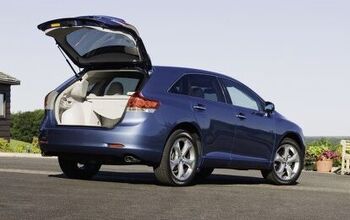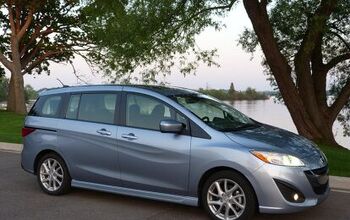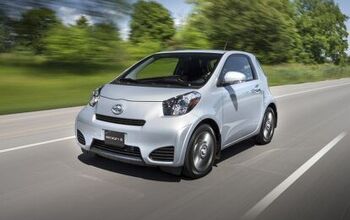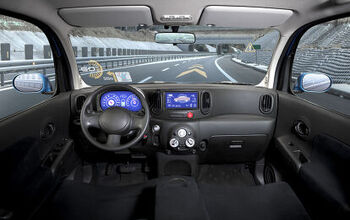The Mitsubishi Lancer Is Dead: Here's Why
Set aside TTAC’s Midsize Sedan Deathwatch for a moment to mourn the passing of a compact car: the Mitsubishi Lancer.
Motor1 reports production of the Lancer will end in August 2017. There will be no replacement.
Mitsubishi vacated the midsize segment four years ago in the service of providing evidence — along with the defunct Dodge Avenger, Chrysler 200, and Suzuki Kizashi — to support TTAC’s Midsize Sedan Deathwatch. Mitsubishi’s overall U.S. sales volume hasn’t suffered as a result. 2016 was the brand’s fourth consecutive year of improved sales in America.
With plans to bolster its crossover lineup, it now appears Mitsubishi’s U.S. dealers won’t suffer greatly from the loss of the increasingly low-volume Lancer, either — at least, not relative to the recent past.
In an age of less costly fuel and discounted midsize cars, it’s easy to blame the gradual decline of small cars in general for the Mitsubishi Lancer’s disappearance.
Perhaps too easy.
While the U.S. passenger car market slid 9 percent in 2016, a near-700,000-unit drop from 2015 even as the auto industry set records, compact car sales were down just 5 percent. The Lancer’s Japanese-brand competitors, which together own 55 percent of America’s compact car market, collectively increased 3 percent.
In other words, small cars can be sold in America in 2017. But evidently, it’s not easy to sell a small car, initially launched for the 2002 model year, that hasn’t been thoroughly revamped since 2007.
Of course, we knew North America’s second-generation Lancer, which you’ll recall is essentially a successor to the Mirage before the Mirage returned as Mitsubishi’s sub-Lancer model, would eventually die. Mitsubishi couldn’t build this antiquated compact forever.
The Lancer Sportback fled the U.S. market at the end of its 2014 model year. Lauded by the enthusiast press, the Lancer Evolution was cancelled after the 2015 model year, though more than 100 Evos languish on dealer lots, according to Cars.com inventory.
Moreover, Mitsubishi’s CEO more than one year ago quite strongly indicated that midsize and compact cars weren’t part of the automaker’s future plans.
The Lancer’s death is all the more official now that Don Swearingen, executive vice president of Mitsubishi’s North American operations, told Motor1 the Lancer’s run ends for good this year. The brand will focus its car portfolio on the Mirage instead. Yes, that Mirage, which according to Swearingen, “our customers love.”
Having long since realized there’s no suitable partner to supply a Galant replacement, and even now with Renault-Nissan’s stake in Mitsubishi clearly not providing a suitable compact partner, Mitsubishi turns to small crossovers instead. The aging Outlander and Outlander Sport already account for more than six out of every ten Mitsubishi sales in America.
Replacements will presumably draw on a legion of utility vehicle concepts revealed over the last half-decade: AR, GC-PHEV, HR-PHEV, HR-PHEV II, eX, and GT-PHEV.
Mitsubishi, of course, hasn’t always been quick off the draw in the crossover sphere. Promising a turbocharged, compact CUV in 2018 that “ will be the best vehicle Mitsubishi has ever produced,” we’re reminded that Mitsubishi has routinely promised the North American arrival of the Outlander Plug-In Hybrid and failed to deliver.
As for the Lancer, nearly 70,000 of which were sold in 2002, its first full year in the U.S., yet sales have declined in 10 of the last 14 years. Lancer sales plunged by two-thirds between 2002 and 2006, when the Lancer last approached a replacement phase. In 2016, Lancer sales in the U.S. were 79-percent lower than in 2002; 54-percent lower than in 2007. Last year, Mitsubishi sold one Lancer for every 26 Honda Civics, one Lancer for every 15 Nissan Sentras, one Lancer for every three copies of the defunct Dodge Dart.
The availability of all-wheel drive apparently does the Lancer no favours. Combined city/highway fuel economy maxes out at 30 miles per gallon: the Civic and Elantra both reach 35 mpg. In a review of an all-wheel-drive 2017 model, Car And Driver complained about the engine, transmission, steering, non-telescoping steering column, seats, trunk, and interior materials, “as if Mitsubishi is sourcing its plastics from a couple of decades ago.”
Unloved and unpopular, the Mitsubishi Lancer clearly deserves to die. In the past, this kind of death in the family prompted many to question Mitsubishi Motors’ future.
In 2017, however, Nissan’s investment in the firm limits questions regarding the overall brand’s viability.
But a budget-priced brand that offers two small crossovers and one Chevrolet Spark-fighting small car isn’t exactly smack dab in the middle of the mainstream, either.
Timothy Cain is the founder of GoodCarBadCar.net, which obsesses over the free and frequent publication of U.S. and Canadian auto sales figures. Follow on Twitter @goodcarbadcar and on Facebook.
More by Timothy Cain
Latest Car Reviews
Read moreLatest Product Reviews
Read moreRecent Comments
- Bd2 Lexus is just a higher trim package Toyota. ^^
- Tassos ONLY consider CIvics or Corollas, in their segment. NO DAMNED Hyundais, Kias, Nissans or esp Mitsus. Not even a Pretend-BMW Mazda. They may look cute but they SUCK.I always recommend Corollas to friends of mine who are not auto enthusiasts, even tho I never owed one, and owned a Civic Hatch 5 speed 1992 for 25 years. MANY follow my advice and are VERY happy. ALmost all are women.friends who believe they are auto enthusiasts would not listen to me anyway, and would never buy a Toyota. They are damned fools, on both counts.
- Tassos since Oct 2016 I drive a 2007 E320 Bluetec and since April 2017 also a 2008 E320 Bluetec.Now I am in my summer palace deep in the Eurozone until end October and drive the 2008.Changing the considerable oils (10 quarts synthetic) twice cost me 80 and 70 euros. Same changes in the US on the 2007 cost me $219 at the dealers and $120 at Firestone.Changing the air filter cost 30 Euros, with labor, and there are two such filters (engine and cabin), and changing the fuel filter only 50 euros, while in the US they asked for... $400. You can safely bet I declined and told them what to do with their gold-plated filter. And when I changed it in Europe, I looked at the old one and it was clean as a whistle.A set of Continentals tires, installed etc, 300 EurosI can't remember anything else for the 2008. For the 2007, a brand new set of manual rec'd tires at Discount Tire with free rotations for life used up the $500 allowance the dealer gave me when I bought it (tires only had 5000 miles left on them then)So, as you can see, I spent less than even if I owned a Lexus instead, and probably less than all these poor devils here that brag about their alleged low cost Datsun-Mitsus and Hyundai-Kias.And that's THETRUTHABOUTCARS. My Cars,
- NJRide These are the Q1 Luxury division salesAudi 44,226Acura 30,373BMW 84,475Genesis 14,777Mercedes 66,000Lexus 78,471Infiniti 13,904Volvo 30,000*Tesla (maybe not luxury but relevant): 125,000?Lincoln 24,894Cadillac 35,451So Cadillac is now stuck as a second-tier player with names like Volvo. Even German 3rd wheel Audi is outselling them. Where to gain sales?Surprisingly a decline of Tesla could boost Cadillac EVs. Tesla sort of is now in the old Buick-Mercury upper middle of the market. If lets say the market stays the same, but another 15-20% leave Tesla I could see some going for a Caddy EV or hybrid, but is the division ready to meet them?In terms of the mainstream luxury brands, Lexus is probably a better benchmark than BMW. Lexus is basically doing a modern interpretation of what Cadillac/upscale Olds/Buick used to completely dominate. But Lexus' only downfall is the lack of emotion, something Cadillac at least used to be good at. The Escalade still has far more styling and brand ID than most of Lexus. So match Lexus' quality but out-do them on comfort and styling. Yes a lot of Lexus buyers may be Toyota or import loyal but there are a lot who are former GM buyers who would "come home" for a better product.In fact, that by and large is the Big 3's problem. In the 80s and 90s they would try to win back "import intenders" and this at least slowed the market share erosion. I feel like around 2000 they gave this up and resorted to a ton of gimmicks before the bankruptcies. So they have dropped from 66% to 37% of the market in a quarter century. Sure they have scaled down their presence and for the last 14 years preserved profit. But in the largest, most prosperous market in the world they are not leading. I mean who would think the Koreans could take almost 10% of the market? But they did because they built and structured products people wanted. (I also think the excess reliance on overseas assembly by the Big 3 hurts them vs more import brands building in US). But the domestics should really be at 60% of their home market and the fact that they are not speaks volumes. Cadillac should not be losing 2-1 to Lexus and BMW.
- Tassos Not my favorite Eldorados. Too much cowbell (fins), the gauges look poor for such an expensive car, the interior has too many shiny bits but does not scream "flagship luxury", and the white on red leather or whatever is rather loud for this car, while it might work in a Corvette. But do not despair, a couple more years and the exterior designs (at least) will sober up, the cowbells will be more discreet and the long, low and wide 60s designs are not far away. If only the interiors would be fit for the price point, and especially a few acres of real wood that also looked real.




































Comments
Join the conversation
Look at all these "I had one as a rental" comments...tells you everything you need to know about this car.
I had a 2010 Sportback GTS for 10 years. Most reliable car I ever own. Never once needed to use that super long warranty - nothing ever went wrong. Regular maintenance and tires was all I did. It's styling was great too. Even after all those years it looked better than many current models. Biggest gripe I had was the interior. Cheap (but durable) materials and no sound insulation to speak of. If Mitsubishi had addressed those items I'm sure it would have sold better.